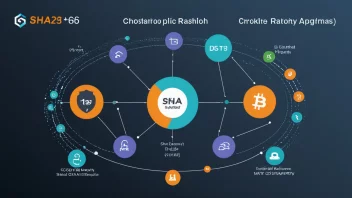Introduction
In the rapidly evolving landscape of digital currencies, the role of cryptographic hashing algorithms has become increasingly paramount. These algorithms not only secure digital transactions but also ensure data integrity and enhance the overall security framework of blockchain technology. In this article, we will explore the top 10 cryptographic hashing algorithms that are crucial for cybersecurity within the context of digital currency regulations.
1. SHA-256
SHA-256 is part of the SHA-2 family and is widely recognized for its robust security features. It produces a 256-bit hash value and is used extensively in Bitcoin and other cryptocurrencies to secure transactions and mine new blocks.
2. SHA-3
SHA-3 is the latest member of the Secure Hash Algorithm family, designed with a different internal structure compared to SHA-2. It offers improved resistance to certain potential vulnerabilities and is adaptable for various applications, including blockchain.
3. BLAKE2
BLAKE2 is known for its speed and security. It is faster than MD5 and SHA-1 while maintaining a high level of security, making it an excellent choice for applications requiring quick hashing without compromising security.
4. RIPEMD-160
RIPEMD-160 is a cryptographic hash function that produces a 160-bit hash value. It is commonly used in cryptocurrency applications, particularly in generating Bitcoin addresses, due to its efficiency and security.
5. Whirlpool
Whirlpool is a cryptographic hash function that produces a 512-bit hash value. It is designed for security and is used in various applications, including file integrity checks, to ensure data has not been tampered with.
6. Keccak
Keccak is the algorithm that won the NIST hash function competition to become SHA-3. Its innovative sponge construction offers flexibility and security, making it suitable for both blockchain and general-purpose hashing.
7. Argon2
Argon2 is a password hashing algorithm that won the Password Hashing Competition in 2015. It is designed to resist GPU cracking attacks and is recommended for secure password storage.
8. Scrypt
Scrypt is another memory-intensive password hashing function designed to make brute-force attacks more difficult. It is widely used in cryptocurrency mining, notably in Litecoin, due to its security and resource-intensive nature.
9. PBKDF2
PBKDF2 (Password-Based Key Derivation Function 2) is used for securely hashing passwords. It applies a pseudorandom function to the input password along with a salt to produce a derived key, making it highly secure for password storage.
10. MD5
MD5 is one of the oldest hashing algorithms. Although it is fast and widely used, its vulnerabilities make it unsuitable for security-sensitive applications. It is often used for checksums and data integrity verification, but should be avoided in favor of more secure alternatives.
Conclusion
The selection of a suitable cryptographic hashing algorithm is crucial in the context of cybersecurity, especially with the rise of digital currencies and their regulatory frameworks. Algorithms like SHA-256 and SHA-3 are at the forefront of blockchain technology, while others like Argon2 and Scrypt focus on secure password storage. Understanding these algorithms and their applications can significantly enhance the security posture of digital currency systems and compliance with regulatory standards.






